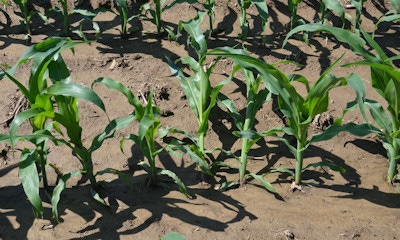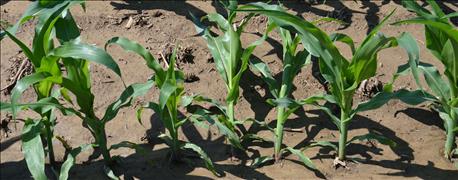
Applying nitrogen pre-plant or as starter isn’t without risk to the crop. Here are 10 points to ponder if you haven’t applied N yet, or if you haven’t planted corn yet..
Providing the discussion points are three Indiana Certified Crop Advisers. They include Jesse Grogan, LG Seeds, Lafayette; Greg Kneubuhler, G & K Concepts, Harlan; and Tom Stein, Ceres Solution, Boswell/Templeton branch manager.
1. The longer you wait to plant after application, the less the risk
“There isn’t always a perfect waiting period after an anhydrous ammonia application,” Kneubuhler says. Ideally, he prefers waiting at least four days.
2. Know the width of the ammonia band

NO INJURY HERE: If there was any injury from anhydrous or other N application burn, these plants have recovered and are on their way.
Ammonia can move three to four inches from the point of injection within 24 hours, Kneubuhler says. That means you have a solid band six to eight inches wide if knives are on 30-inch centers. That’s one reason why it’s possible to get symptoms of burn from preplant applications.
3. Go deeper to avoid burn
One way to avoid symptoms is to place ammonia deeper than normal, Kneubuhler says. He is talking about placing it eight to 10 inches deep.
4. Where GPS technology can help
If you have auto-steer capability, it might be useful while planting, Knuebuhler says. “It could help you make sure you stay away from the knife slot,” he explains.
Related: What's your risk for corn nitrogen deficiency?
5. Learn to recognize the symptoms of N injury
Symptoms vary, Stein says. If it is true N injury, look for dead, rotted seed, roots that are sheared, pruned burnt and discolored, stunted, wilted seedlings with yellow and brown leaves and necrotic tips on leaves. Stands may be uneven, with dead or missing plants.
6. Determine ability of the crop to recover
It will depend on the severity of the burn in the first place, Stein notes. Additional rainfall could dilute the salt concentrations and assist some of the seedlings with recovery.
7. Look for patterns in the field
If the injury or plant death is actually caused by an anhydrous ammonia application, there could be a pattern in the field, Grogan says. “See if plants are dying over banded application strips from the anhydrous knives,” he suggests.
Related: 17 ways to improve corn yield
8. Consider application direction if you haven’t applied N yet.
One option is to inject preplant N on an angle. Then rows won’t line up entirely over a band. However, it negates the ability to use auto-steer to totally avoid bands for all rows.
9. Distinguish anhydrous injury from starter fertilizer burn.
“Starter fertilizer injury produces a different pattern across the field, usually confined to the row, showing symptoms compared to other rows in the planter pass,” Grogan explains. “The most common cause of this type of injury is a fertilizer knife out of adjustment, running too close to germinating seedlings.
10. Separate it from injury caused by disease
If pathogens cause the injury that you suspect might be fertilizer burn, look for patterns again, Grogan says. “Look for a sporadic pattern in the field and a light brown, watery appearance on several roots, but not all roots. That’s more indicative of disease.”
About the Author(s)
You May Also Like




